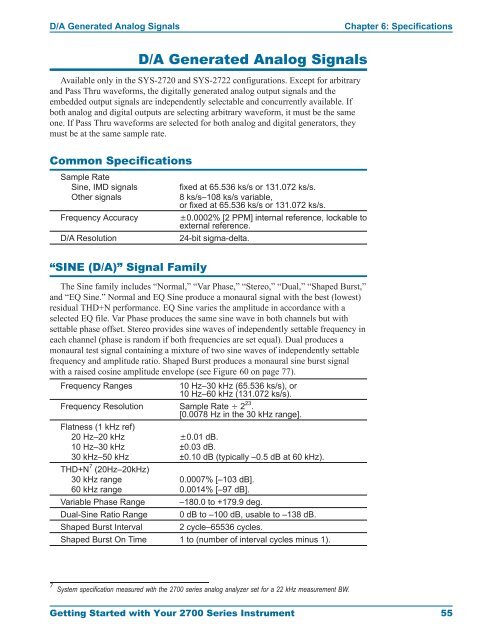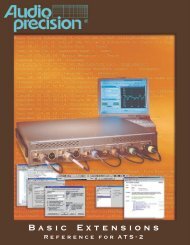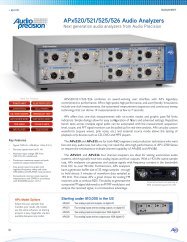Getting Started with Your 2700 Series Instrument
Getting Started with Your 2700 Series Instrument
Getting Started with Your 2700 Series Instrument
Create successful ePaper yourself
Turn your PDF publications into a flip-book with our unique Google optimized e-Paper software.
D/A Generated Analog Signals Chapter 6: Specifications<br />
D/A Generated Analog Signals<br />
Available only in the SYS-2720 and SYS-2722 configurations. Except for arbitrary<br />
and Pass Thru waveforms, the digitally generated analog output signals and the<br />
embedded output signals are independently selectable and concurrently available. If<br />
both analog and digital outputs are selecting arbitrary waveform, it must be the same<br />
one. If Pass Thru waveforms are selected for both analog and digital generators, they<br />
must be at the same sample rate.<br />
Common Specifications<br />
Sample Rate<br />
Sine, IMD signals fixed at 65.536 ks/s or 131.072 ks/s.<br />
Other signals 8 ks/s–108 ks/s variable,<br />
or fixed at 65.536 ks/s or 131.072 ks/s.<br />
Frequency Accuracy 0.0002% [2 PPM] internal reference, lockable to<br />
external reference.<br />
D/A Resolution 24-bit sigma-delta.<br />
“SINE (D/A)” Signal Family<br />
The Sine family includes “Normal,” “Var Phase,” “Stereo,” “Dual,” “Shaped Burst,”<br />
and “EQ Sine.” Normal and EQ Sine produce a monaural signal <strong>with</strong> the best (lowest)<br />
residual THD+N performance. EQ Sine varies the amplitude in accordance <strong>with</strong> a<br />
selected EQ file. Var Phase produces the same sine wave in both channels but <strong>with</strong><br />
settable phase offset. Stereo provides sine waves of independently settable frequency in<br />
each channel (phase is random if both frequencies are set equal). Dual produces a<br />
monaural test signal containing a mixture of two sine waves of independently settable<br />
frequency and amplitude ratio. Shaped Burst produces a monaural sine burst signal<br />
<strong>with</strong> a raised cosine amplitude envelope (see Figure 60 on page 77).<br />
Frequency Ranges 10 Hz–30 kHz (65.536 ks/s), or<br />
10 Hz–60 kHz (131.072 ks/s).<br />
Frequency Resolution Sample Rate 2 23 .<br />
[0.0078 Hz in the 30 kHz range].<br />
Flatness (1 kHz ref)<br />
20 Hz–20 kHz 0.01 dB.<br />
10 Hz–30 kHz ±0.03 dB.<br />
30 kHz–50 kHz<br />
THD+N<br />
±0.10 dB (typically –0.5 dB at 60 kHz).<br />
7 (20Hz–20kHz)<br />
30 kHz range 0.0007% [–103 dB].<br />
60 kHz range 0.0014% [–97 dB].<br />
Variable Phase Range –180.0 to +179.9 deg.<br />
Dual-Sine Ratio Range 0 dB to –100 dB, usable to –138 dB.<br />
Shaped Burst Interval 2 cycle–65536 cycles.<br />
Shaped Burst On Time 1 to (number of interval cycles minus 1).<br />
7 System specification measured <strong>with</strong> the <strong>2700</strong> series analog analyzer set for a 22 kHz measurement BW.<br />
<strong>Getting</strong> <strong>Started</strong> <strong>with</strong> <strong>Your</strong> <strong>2700</strong> <strong>Series</strong> <strong>Instrument</strong> 55




